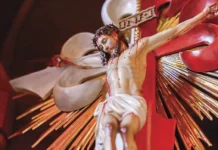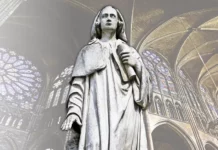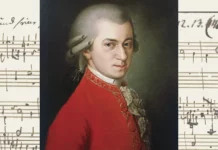The history of the oldest shrine of the West dedicated to St. Michael is filled with marvels and mystery. From this site, devotion to the combative Archangel spread throughout the whole Church. Today, is it nothing more than a quaint throwback to the distant past?
Located at an elevation of eight hundred metres, upon an imposing promontory that juts into the Adriatic Ocean, the Shrine of St. Michael the Archangel of Monte Gargano calls attention for is unique architecture and its geographic position.
It is composed of a cluster of small buildings charmingly grouped on the mountain crest. At the centre is the small grotto where the Guardian of the Church appeared in the early Middle Ages.
Since that remote time, the place became a focal point of devotion to the Holy Archangel for the entire Church. Across the ages, millions of pilgrims, including many Popes, kings and Saints, have visited the famous shrine. Its history, however, is lost in the mists of time.
The arrow turns against the archer
Ancient chronicles relate that in the year 490 a nobleman from Siponto, which today is part of the Italian commune of Manfredonia, was searching the vicinity for one of his bulls that had wandered away from the herd. After combing the area for several hours and overcome by exhaustion, he was on the point of returning home when he finally spied the animal.
It was at the entrance of a rocky cave of difficult access at the highest part of the hill overlooking the city. It soon became apparent that its rescue would be almost impossible. In a gesture of exasperation, the nobleman shot an arrow meaning to kill the animal, but to the surprise of those who witnessed the scene, the arrow turned back to its point of departure, wounding the archer instead.
When they learned of the occurrence, the locals of Siponto asked their Bishop, St. Laurence Maioranus, to interpret the mysterious episode to them. In reply, the pious prelate decreed a three-day fast, during which everyone was to ask God to reveal to them His sublime designs concerning the incident.
The answer to these prayers and sacrifices was not long in coming. At sunrise on the fourth day, May 8, 490, while St. Laurence was at prayer in the Church of St. Mary Major, the old cathedral of Siponto, the glorious Prince of the Heavenly Militia appeared to him and said: “You have done well in seeking to discover the mystery of God which is hidden from men, the reason for which I struck them with my lance. Be it known, however, that this is my express will. I am Michael the Archangel and I am always in the presence of God. I come to dwell in this place, to watch over it, and to prove by means of a sign that I am its sentry and guardian.” 1
The angelic spirit also promised that he would grant any favour requested of him in prayer at that site, and he asked that the grotto be dedicated to Christian worship. And, as proof of his power, he miraculously cured the nobleman who had been pierced by the arrow. Even the marks of the wounds disappeared.

St. Michael obtains victory
News of the occurrence spread across Europe and over the Mediterranean, reaching Constantinople. Meanwhile, the faithful in Siponto adopted the custom of climbing Monte Gargano to request the intercession of the Holy Archangel, who obtained favours for them in great abundance.
He worked one of his greatest wonders two years after the first apparition. When the city found itself besieged by a powerful barbarian army, St. Laurence climbed to the celestial grotto to implore victory from the Archangel, and counselled the people to request a three-day truce, during which they were to fast and pray in honour of the God of hosts.
The invaders accepted the armistice, and after the stipulated time had elapsed, St. Michael appeared once again to the prelate as he prayed in the cathedral of Siponto. It was early morning of September 29, 492. He came to announce victory to them and to warn them not to attack the invaders until after four o’clock that day.
The holy Bishop summoned the people and conveyed the instructions received from Heaven. Flooded with joy, the defenders of the city spent the following hours in prayer, and at the moment determined by the Archangel, they went to meet their adversaries. According to one chronicler, the invaders banked on their pride, while the people of Siponto confided in the angelic promise. 2
When the battle began, a thick cloud covered Monte Gargano. The earth began to shake, the ocean roared and frothed, and a fearsome storm broke out. Lightning bolts struck the barbarians, but spared the people of Siponto. Terrorized, the enemy horde took to flight.
In thanksgiving, the Bishop led the people in procession to the Archangel’s grotto, in front of which they found footsteps similar to those of a man, stamped in the rock. They immediately attributed them to St. Michael. The people dared not enter the cave, but venerated those imprints left by the angelic spirit as an unmistakable sign of his presence and protection.
“I myself consecrated this place”
On the eighth day of the month of May, in 493, Bishop Laurence returned to the grotto to commemorate the third anniversary of the first apparition. He was eager to transform that solitary place into a true sanctuary where God would be praised and where the Holy Mass would be celebrated regularly, but he was unsure of how best to proceed with the project.
To resolve the dilemma, he decided to present the problem to Pope St. Gelasius, recently ascended to the Papal Throne. The Pontiff received the Bishop’s messengers benevolently, but instead of furnishing a solution to the question, he urged him to discover the will of the Archangel with these words: “If it were for us to determine the day of the dedication of the church chosen by St. Michael, we would make it the day of the victory over the barbarians, but since it befits the Holy Prince to define it, we await his oracle.” 3
In this same missive, the Pontiff asked St. Laurence to proclaim a three-day fast in Siponto, in which seven virtuous prelates of neighbouring dioceses should participate, and he proceeded to name them. The Holy Father also promised to unite himself, in Rome, to the prayers being offered.
The prayers of a saintly Pope, united to those of such virtuous prelates could not fail to be attended. On September 26 of 493, the solemn triduum prescribed by St. Gelasisus began. And, on the night of the 29th, St. Laurence received the third oracle of the Archangel, who appeared to him saying: “It shall not be for you to dedicate this basilica that I erected, but for me, who laid its foundations. As its walls are raised up, the sins of the men who visit it will diminish, for in the bosom of this most special house, the works of evil vanish. Enter it, and pray assiduously within it, aided by me, its patron. And when Masses are celebrated, let the people receive Communion according to custom. I shall personally take it upon myself to sanctify this place.4
At dawn the next day, prelates and faithful went to the grotto. The signs promised by the Archangel began along the way, during which the sun beat down strongly. Suddenly four giant eagles joined the entourage. Two provided shade for the Bishops and the people and the other two produced a refreshing breeze with their wings.
Upon arriving at the grotto, they saw an effigy of St. Michael imprinted on the wall, and, when they stepped inside they found an altar carved in the rock and adorned with a crystal cross – a symbol of the promised consecration.

Centuries of devotion to St. Michael
When Pope Gelasius learned from St. Laurence of the wondrous happenings of that day, he established for all time that September 29 would be dedicated to St. Michael in the Universal Church. Later, St. Gabriel and St. Raphael would also be commemorated on this date, giving rise to the current liturgical memorial of the three Archangels.
Over subsequent centuries, the history of the shrine accompanied the vicissitudes of the era, marked by the Byzantine-Lombard clashes. In the eleventh century, the old church was built, whose ruins exist to this day.
Among the Popes and medieval Saints who visited the sanctuary are St. Bernard, St. William of Vercelli, St. Thomas Aquinas, St. Catherine of Siena and St. Francis of Assisi. The latter, feeling unworthy to enter the grotto, stopped in prayer at the entrance of the cave, kissed the ground and carved the tau cross on one of its stones.
In 1656, there would be yet a fourth apparition, during the terrible epidemic that swept through Italy, carrying off many victims. On this occasion, Dom Giovanni Alfonso Puccinelli, Archbishop of Manfredonia determined that prayers and fasts should be carried out, to beseech the aid of the heavenly protector, and he left a written supplication in the hands of the statue of St. Michael. While he prayed, the Archangel manifested himself and ordered him to bless fragments of stone from the grotto, upon which he should carve his name and the Sign of the Cross. All those who used them would be cured of the plague. This, is in fact what happened.
United to St. Michael we shall be victorious
Today, the shrine of Monte Gargano continues to be a busy centre of pilgrimage, enhanced by its proximity to San Giovanni Rotondo. However, the modern mentality seems to have relegated its venerable history and the devotion to the Archangel practised there to a quint throwback to a remote past, of little relevance to the present.
Nothing could be more erroneous. Today the Church is engaged in a fierce spiritual battle, in which the devil is carrying off an increasing number of souls. St. Michael has a most important role in this fight. Being not only the shield of the Church, but also its sword, the Prince of the Lord’s armies is called not only to protect us against the wiles of the enemy but also to inflict one its bitterest downfalls.
We ought, therefore, to grow in devotion to this heavenly Archangel, certain that if we are united to such an undefeatable general we will become invincible and strong as was the heavenly militia, making this decisive and triumphant cry echo through the entire empire of satan: “Quis ut Deus!” ◊
A curious coincidence?
The Sanctuary of Mount Gargano is part of a series of seven sites connected with the Guardian of the Church which, though separated by great distances, are aligned on the map. They thus form what has been called the Sacred Line of St. Michael the Archangel.
At the northwest end of this straight line is an uninhabited island of Ireland, where the Prince of the Heavenly Militia appeared to St. Patrick. There, at the end of the sixth century, was built the Skellig Michael Monastery, one of the oldest and most remote in the Christian world. Continuing south, we come upon Cornwall, England, with the island of St. Michael’s Mount on which, according to an ancient tradition, the Archangel appeared to a group of fishermen in the fifth century.
Crossing the English Channel, we arrive at the famous Mont Saint-Michel Abbey, site of the apparition to the Bishop of Avranches, St. Aubert. From there we advance to a large rock dominating Piedmont, on the other side of the Alps, on which stands the Sacra di San Michele, an ancient monastery dedicated to the Guardian of the Church. And still within Italian territory, but on the shores of the Adriatic Sea, lies the Sanctuary of Mount Gargano.
On the Greek island of Symi, off the coast of Turkey, is the Orthodox Monastery of Panormitis, built over an ancient mid-fifth-century Christian church dedicated to St. Michael. And at the southeast end of this straight line rises Mount Carmel, abode of the prophet Elijah and also in some way related to the Archangel.
It is noteworthy that the two most important structures in this series – Mont Saint-Michel and Monte Gargano – are located on the seafront, exactly the same distance from the Sacra di San Michele, situated in the heart of Europe.
One might wonder whether this line of shrines is just a curious coincidence. Or does it, as more imaginative spirits claim, correspond to the terrible sword with which the Archangel struck down Lucifer during the prælio magno in Heaven? It is impossible for us to penetrate so hidden a mystery. But God does nothing by chance; big or small, everything for Him has its meaning. We will know it someday.

Notas
1 LUCERA, Giuseppe Marinelli di. Ragguaglio del venerabile ed insigne Santuario dello Arcangelo S. Michele nel Monte Gargano. Napoli: Tipografia di Gennaro Fabricatore, 1858, p.8.
2 Cf. Idem, p.17.
3 Idem, p.24.
4 Idem, p.25-26.








Please pray for me and my broken family, for my son and daughter, healing of mind and body, healing for my tumour and that my son will heal and return to his faith. Grew up in an abusive family struggling with anger and dealing with evil people in my own family and people around me and yes I know it not from God. I need to get a mass said at the shrine is their a way I can do that. I love st Micheal.
Although we have no connection with the Shrine mentioned in the article, I would be happy to place all of your intentions in the Mass celebrated here in our community. May God bless you and St. Michael protect you!
Praise the lord father
Father, pray for Israel and the whole world family of Israel, now Israel is in emergency, defeat the Iranian terrorist and the evils of Hamas in Jesus name, Amen.
Pray for the peace in Jerusalem……I got a news just now Amen
Dear holy mother of our God
Please pray for me and my family intentions, devils are attacking us somehow, physically, mentally spiritually and emotionally. Please pray that the demons and the serpents be destroyed and sent back to hell forever, no more to return to our life. Blood of Jesus Christ cover me and my family now and forever, Amen.
Please help us to be helped by our Redeemer soon and urgently in Jesus name Amen.
Grant us Holy Spirit and peace, pray for family members protection and the whole of Israel
Thank you
Payal
Dear blessed sisters
Please pray for my healing, that I may receive the holy spirit and peace, pray for every present trial and temptation, pray for my parents’ souls to be in rest in peace. Pray for my sisters and families be blessed and protected, increase my faith and help me to honour our Lord God Jesus and love him sincerely and honestly…take away every fear from me and anxiety, grant me good health. In Jesus name Amen thank you
Miss payal
Buen día!
La paz de Jesús,!
Mi nombre es Yuverlys Oñoro Barajas, consagrada a Jesus por Maria en Floridablanca Santander Colombia y seguidora de esta linda y amorosa comunidad Heraldos del Evangelio – Caballeros de la Virgen.
Les escribo con gran necesidad pidiendo una ayuda muy especial: mi hijo se llama Angel Mauricio Duarte Oñoro, tiene 11 años y su santo de devoción es San Miguel Arcangel; él de cumpleaños quiere la reliquia de la piedra del Monte Gargano, ese es su deseo de cumpleaños, por que imagenes ese niño tiene de San Miguel.
Yo humildemente no puedo ni viajar allá, soy de bajo recurso pero muy digna hija del Rey de reyes, Cristo, así que me tomo el atrevimiento que si me pueden ayudar. Es que me dicen que las reliquias las venden y demás allá en Italia, es para poder ahorrar y poder mandarlas a traer.
Es más: si requieren evidencia de mi hijo y yo, con muchisimo gusto me pueden revisar en redes sociales, estoy como YUBE OÑORO y tengo la foto de una camiseta azul detras el cuadro de la Virgen de Guadalupe.
Quedo muy atenta les pido perdón por el atrevimiento de escribirles, pero una mamá lucha por cumplir los sueños de sus hijos.
Cordialmente,
Yuverlys Oñoro Barajas
¡Salve María, Dña. Yuverlys Oñoro!
Es una satisfacción tenerla como lectora de nuestra Revista en su versión online.
Pero la alegría es más grande al saber que desea Ud. dar tal regalo a su hijo, a raíz de un artículo nuestro publicado. Sin embargo, ese regalo no es muy fácil de obtener…
En todo caso, ya encaminamos su mensaje a los responsables en Colombia y vamos a hacer todo lo posible para ayudarle. Ellos deben entrar en contacto con Ud.
Agradecemos su participación y deseamos que Nuestra Señora le ayude, así como a su familia. Y que San Miguel proteja especialmente a Angel Mauricio.
En Jesús y María,
Hna. Juliane Campos
St. Michael, Defend us in this day of BATTLE, pray for the youth of the world, caught up in Satan’s snares and lies, pray for all FAMILIES, struggling, with fallen away members, of our Holy, Catholic Faith, and PLEASE ST. MICHAEL, PRAY FOR PEACE ON EARTH NOW, BEFORE GOD’S THRONE, WHO’S FACE YOU SEE… AMEN….
I pray for my salvation and that of all people, for the health and long life of my mother, for the health of my sister, mine and all those for whom I pray. I pray for God’s forgiveness, blessings, protection and help. Thank you.
I pray for the salvation of all of us, for the conversion of the dying, for God’s blessing, reconciliation, protection and help, for the preservation of work, for successful studies for Pavla and Martin, for the health of my mother, my sister and all I am praying for.
I ask for God’s blessings, protection and help, for health and long life for my mother and sister, for health for me and all those for whom I pray. I ask for the successful completion of my studies for my niece and friends. I ask for peace with God and people and for the salvation of us all. Thank you.
I ask for my salvation and everyone’s, for the health and long life of my mother and sister, for my health and the health of those for whom I pray. I ask for peace and reconciliation with God and people, for God’s blessing, protection and help. Thank you.
I pray to St Michael, the Archangel to grant me the gift of discernment and to be my guide, especially through these dark times when my boss is not speaking to me. May my boss forgive me all my offences so that healing and peace can come. I pray that my boss will give me some permanent work. May he include me in work events and meetings. In short, please pray through St Michael’s intercession for clarity, understanding, the opportunity to speak to Michal. St Michael, give Michal the courage to speak to me again. Amen